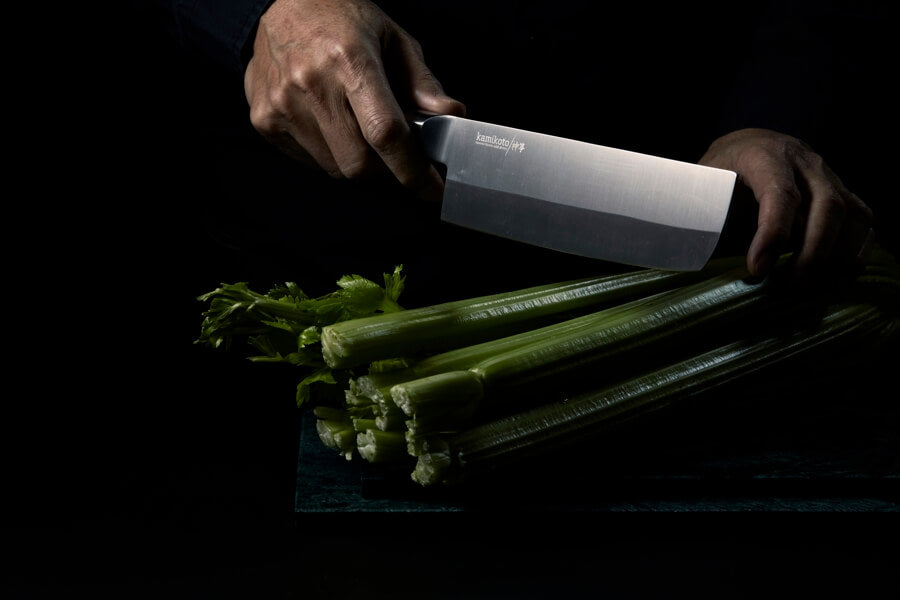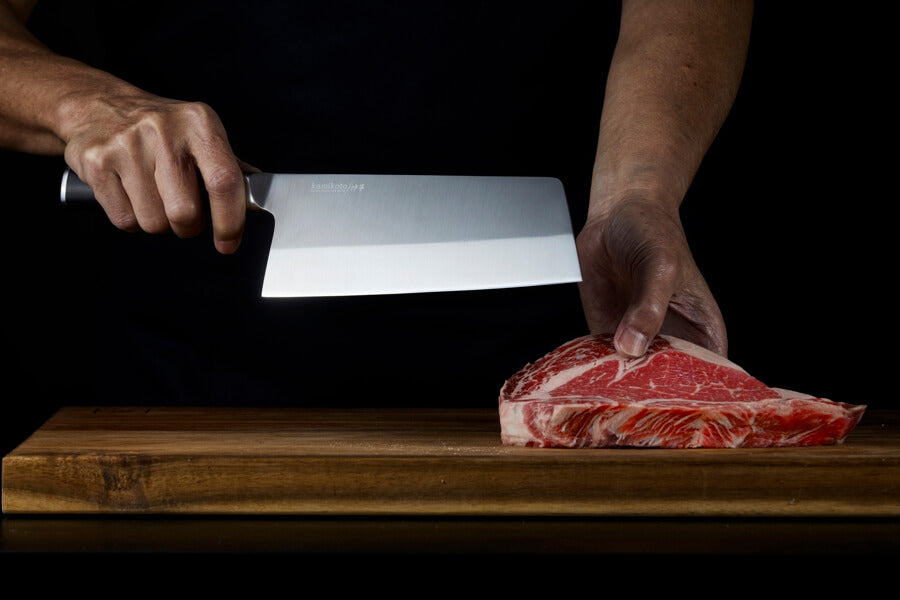
From slicing and dicing, to carving and paring, every kitchen needs a professional set of knives. Whether you’re ready to add to your own collection of Japanese knives, or simply looking for a place to start, this guidewill help you make the right choice.
To break it down, we look into the different lengths and types of knives, as well as which ones to use based on your experience in the kitchen.
What Kitchen Knives Do I Need?
Chefs must work with the best available tools and the right blade will allow you superior precision and skill. Different knives serve different purposes. If you only cook occasionally, you may only need a paring knife and a chef’s knife. But if you like to cook every day and experiment with different meals, a larger range of professional Japanese Honshu steel knives will suit you better. Essentially, the types of kitchen knives you need depend on your level and field of cooking, as well as the skill and techniques you need from a blade.
Understanding Knives by Type

Chef’s Knives
The chef’s knife is one of the most versatile knives to have in your kitchen. With its broad and sharp blade, it is a multi-purpose knife used for a variety of kitchen tasks.

- Length Range: From 6-14 inches
- Ideal for:
- Cutting meat
- Dicing vegetables
- Disjointing some cuts
- Slicing herbs
- Chopping nuts.
- Not ideal for:
- Cleaving meat bones
- Carving dense meat
- Disjointing some cuts
- Slicing bread
- Smaller precision tasks, such as peeling and mincing.
Utility Knives
Longer than a paring knife, but shorter than a chef’s knife, the utility knife is a solid all-rounder in the kitchen. Available in both a serrated and straight blade style, they are sometimes referred to as “sandwich knives”.
- Length Range: From 4-7 inches
- Ideal for:
- Slicing meat
- Slicing bagels and buns
- Cutting sandwiches
- Chopping vegetables
- Slicing herbs
- General kitchen tasks when no other knife will do.
- Not ideal for:
- Cleaving meat bones
- Slicing loaves of bread
- Precision tasks such as peeling and mincing.
Slicing Knives
Similar to carving knives, slicing knives have long, thin blades with either a round or pointed tip. With a more flexible blade than a carving knife, they are used to cut thinner slices of roast, fruits and vegetables.
- Length Range: From 8-14 inches
- Ideal for:
- Slicing and carving thin cuts of meat, such as chicken, pork, beef, venison, fish
- Preparing fruit for salads
- Preparing Vegetables
- Not ideal for:
- Cleaving meat bones
- Small precision tasks, such as peeling and mincing.
Paring Knives
The paring knife is a small, short-bladed knife, used for intricate cutting, peeling, mincing and dicing. The blades are simple, sharp and precise.
- Length Range: From 3.5-4 inches, although some come in 2.5 inch ranges
- Ideal for:
- Peeling and cutting small fruit and vegetables
- Deseeding fruits
- Deveining prawns
- Cutting vegetables & herbs such as garlic
- Not ideal for:
- Preparing or slicing meat, including carving & deboning
- Cutting larger and tougher vegetables, such as pumpkin or other squash
- Slicing bread
Vegetables Knives

As the name suggests, a vegetable knife is primarily, or even exclusively, used to cut vegetables. Though most kitchen knives, particularly paring knives and chef’s knives, are used to cut vegetables, the straight-edged Japanese Nakiri Bocho are designed specifically for the task.
- Length Range: From 5-7 inches
- Ideal for:
- Preparing vegetables, including cutting, chopping, slicing, and dicing both small and large vegetables.
- Not ideal for:
- Cutting and cleaving meat
- Slicing bread
Cleaver

The cleaver, also known as a ‘butcher’s knife’, is a thick, heavy-set knife with a sharply beveled edge. Most often found in butchers and restaurants preparing their own meat. The thickness of the blade can range dramatically depending on the intended purpose of the cut.
- Length Range: From 6-12 inches
- Ideal for:
- Splitting meat from bone, used typically for beef, pork, chicken and other thick types of meat.
- Splitting larger and thicker vegetables, such as melons and squash.
- Smaller cleavers are used for quickly dicing vegetables and fruits.
- Not ideal for:
- Small or delicate slicing of vegetables or boneless meat.
- Simple or quick cutting for pastries or other smaller dishes.
Knives by Length

3.5 Inch Knives
Knives this small are normally referred to as paring knives. Designed for a variety of purposes, they are ideal for professionals.
- Come in a variety of styles, both for cooking and other practical purposes
- Used for chopping, slicing, and peeling small, soft fruits such as apples and citrus fruits, as well as vegetables, chopping herbs, deveining prawns, and scraping seeds
- Not used for bigger tasks such as carving, boning and butchering boneless meats such as chicken breasts or smaller cuts of red meat, cutting larger and tougher vegetables, such as pumpkins or other types of squashes, or slicing bread.
5 Inch Knives
Knives of this length are generally utility knives, such as that found in the Kanpeki Knife Set. They are the perfect middle ground between a paring knife and chef’s knife – an essential piece of equipment in every kitchen.
- Varieties include serrated blades, used for working through rougher foods, and straight blades for clean cuts.
- Used for slicing boneless meat, slicing bagels and buns, cutting sandwiches, and chopping common, garden-variety vegetables and herbs.
- Not used for carving tough meats, cleaving meat bones, slicing loaves of bread, or smaller precision tasks, such as shaping pastries.
7 Inch Knives
This length is generally the domain of the chef’s knife, such as the Santoku chef’s knife or smaller cleavers such as the Chuka Bocho Cleaver. A step up from utility knives, they’re perfect for all experience levels and kitchens. Boning knives also come in this length.
- Varieties include chef’s knife (serrated and straight), Santoku chef’s knife, some varieties of cleavers and boning knife.
- Chef’s knives and Santoku chef’s knives are used for cutting prime meats such as those prepared by a butcher or vendor, dicing common vegetables, disjointing some cuts, slicing herbs, and chopping nuts.
- Boning knives are used for boning cuts of meat, fish and poultry, and removing skin from meat and fish.
- Not all 7 inch knives are used for cleaving meat bones, slicing bread, or smaller precision tasks, instead relying on knives with specific specialities.
8.5 Inch Knives
8.5 inch knives are designed for larger food preparation tasks. In this category, you’ll mostly find chef’s knives, carving knives, and slicing knives – ideal for people who cook larger mains such as roasts and braising cuts. You can also find bread knives in this length.
- Varieties include chef’s knives and carving knives (serrated and straight blade), and bread knives.
- Chef’s knives are used for cutting meat, dicing vegetables, disjointing some cuts, slicing herbs, and chopping nuts, but there are a number of different varieties for separate purposes, including carving, slicing and bread knives for specific ingredients.
- All knives aren’t used for cleaving meat bones or smaller precision tasks.
12 Inch Knives
At this end of the spectrum you’ll predominantly find longer chef’s knives and carving knives. These are ideal for people more confident with handling knives, or who prepare and cook dense cuts of meat, both with and without bones, and vegetables such as squash and melons. They should be a staple for professional chefs, as well as everyday cooks who like to experiment with larger meals.
- Varieties include larger chef’s knives and carving knives (serrated and straight blade).
- Larger chef’s knives are used for cutting meat, dicing vegetables, disjointing some cuts, slicing herbs, and chopping nuts.
- Carving knives are used for slicing and carving dense meats.
- Slicing knives are used for cutting thinner slices of roast, fruit and vegetables.
- All knives aren’t used for cleaving meat bones or smaller precision tasks.
Picking The Right Kitchen Knife For You

Choosing the right knives will depend on what level you’re at in the kitchen, as well as the types of meals you want to cook. To break it down, here’s what you need to know.
For Everyday Cooking
When it comes to everyday cooking, versatility is key. If you’re an everyday cook, you likely cook simple meals most days of the week, and occasionally bigger and more complex meals when you’re entertaining. Therefore, you’re not likely to need a full set of professional kitchen knives. The best knives to have in your kitchen are a:
- Chef’s knife
- Paring knife
- Utility knife
- Carving knife
Pastry Chef
The pastry chef, who specialises in pastries, bread, muffins, cakes and more sophisticated baked goods such as mille-feuille and plated desserts will need a small yet versatile array of knives to approach a range of ingredients used in baking, as well as for slicing and cutting the finished products. These include a:
- Chef’s knife
- Paring knife
- Bread/cake knife
Aspiring Chef
The aspiring chef are those aiming to grow their skills, normally in the confines of their own home, but none would deny that they are normally quite proficient in the kitchen. They enjoy cooking on a regular basis, entertaining for friends and family, and experimenting with new dishes. The aspiring chef may not yet have all of the skills and experience of the professional, but they are still often knowledgeable and passionate chefs and will need a durable set of kitchen knives, including a:
- Chef’s knife
- Paring knife
- Bread knife
- Utility knife
- Carving knife
Apprentice Professional
An apprentice chef is someone who gets paid to learn the skills needed to become a professional. This means they will need a broad range of knives to cater for a wider spectrum of cooking techniques, styles and dishes. In the kitchen, an apprentice chef needs at least a:
- Chef’s knife
- Utility knife
- Paring knife (different varieties)
- Boning knife
- Carving knife
Professional Chef
A professional chef has completed an apprenticeship and works in a restaurant, café or other food establishment. They have high-level skills and knowledge of different cooking styles, cuisines, techniques, and dishes. Therefore, any professional chef will need a wide range of kitchen knives in varying lengths, including a:
- Chef’s knife
- Paring knife (different varieties)
- Utility knife
- Boning knife
- Carving knife
- Slicing knife
- Cleaver
- Butcher knife
While some kitchen knives serve single purposes, others are used for a variety of reasons. With all the different styles, sizes, lengths and brands, it can certainly get a little overwhelming. But armed with the calculated precision of Kamikoto’s razor-sharp knives crafted from Japanese steel, the most demanding work can be performed with greater ease. With the right blade, you can control and conquer any high-performance cooking tasks.
By reading this guide, whether you are already a professional or aspiring to greater heights, you can always hope to grow your knowledge of the purpose and best use of different blades, helping you master the culinary world, and make the best choices possible for your next triumph. With the right knives in your kitchen and the spirit of ancient techniques, your high grade Honshu steel knives will allow you to experience true expertise.


